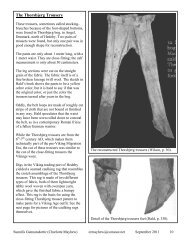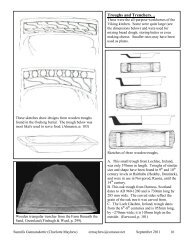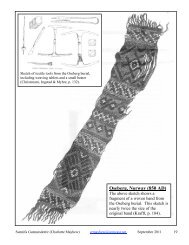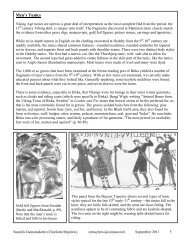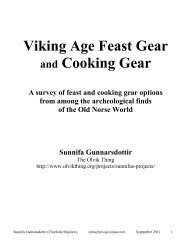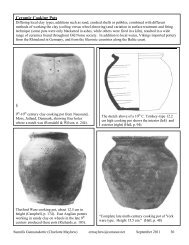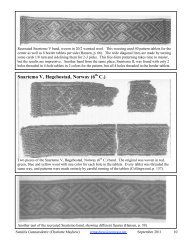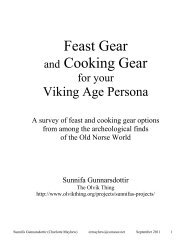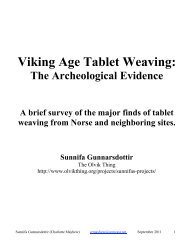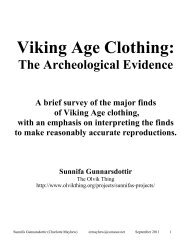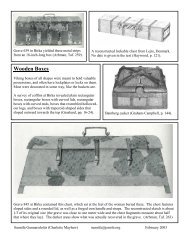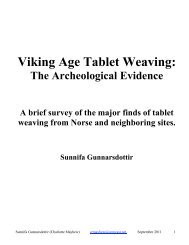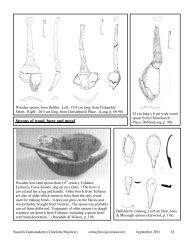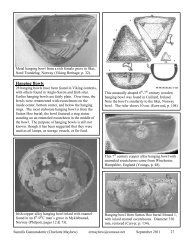Viking Age Clothing Class Handouts pgs 21-26 ... - Olvik Thing
Viking Age Clothing Class Handouts pgs 21-26 ... - Olvik Thing
Viking Age Clothing Class Handouts pgs 21-26 ... - Olvik Thing
Create successful ePaper yourself
Turn your PDF publications into a flip-book with our unique Google optimized e-Paper software.
Underdresses<br />
Very few textile remains of women’s<br />
underdresses survive. Still, there is plenty of<br />
evidence they wore long dresses under their<br />
apron-dresses—the gold foil figures, the<br />
valkyrie figures and the Oseberg Tapestry all<br />
show the women wearing long dresses. The<br />
underdresses were most likely made of linen,<br />
which does not survive well in graves. To<br />
make a <strong>Viking</strong> underdress, a simple t-tunic<br />
works fine, especially for earlier period<br />
<strong>Viking</strong>s. Take the side waste pieces, flip them<br />
over, and add them to the skirt sides for a more<br />
full skirt. You can also try following the<br />
pattern directions for the location-appropriate<br />
men’s tunics (rounded or straight sleeves, for<br />
instance), adjusting the pattern to make a<br />
longer, fuller-skirted garment.<br />
The backside of a bronze tortoise brooch found<br />
in Birka, with some of the pleated linen underdress<br />
still visible (Harte and Ponting, p. 318).<br />
The 1000 AD Eura, Finland underdress was made of<br />
wool. Because of the Baltic propensity to wear a lot<br />
of bronze jewelry, enough of the dress survived for us<br />
to know the length of it (because of the coiled bronze<br />
wire appliquéd to the bottom of the apron), and the<br />
length of the sleeves (because of the coiled bronze<br />
bracelets). The Finnish reconstructors based this<br />
cloth-conservative pattern on a Danish Iron-<strong>Age</strong><br />
leather tunic (Priest-Dorman, p. 60).<br />
Sunnifa Gunnarsdottir (Charlotte Mayhew) crmayhew@comcast.net September 2011 <strong>21</strong>
Apron-Dresses<br />
Apron-dresses are the quintessential <strong>Viking</strong><br />
woman’s garment; the largest surviving example<br />
of an apron dress is the fragment from Hedeby.<br />
The apron-dress fragment recovered at Hedeby,<br />
dated to the 10 th century. The shaded area in the<br />
drawing represents felting on the garment, which<br />
likely indicates a belt was worn. The darts point<br />
towards a fitted style overdress. The cloth was a<br />
fine tabby wool that was dyed brown The seam<br />
was covered with a four-string braid that was<br />
laid down over it. The dress fragment measured<br />
approximately 23cm across, with the bottom<br />
piece measuring almost 25cm across (Hägg,<br />
Haithabu, p. 39 and Shelagh Lewins’ website for<br />
translation of Hägg’s text).<br />
The evolution of the <strong>Viking</strong> apron-dress from<br />
peplos to fitted 10 th century apron-dress found in<br />
Birka and Hedeby (Priest-Dorman, p. 45).<br />
Sunnifa Gunnarsdottir (Charlotte Mayhew) crmayhew@comcast.net September 2011 22
Reconstructed Eura, Finland, Dress<br />
Apron Dress from Birka<br />
This outfit from Eura, Finland, dates to 1000<br />
AD (Fitzhugh & Ward, p. 111). The peplos<br />
style overdress is made of a large rectangle<br />
that wraps around one side of the body and is<br />
left open on the other. This style of overdress<br />
pre-dates the fitted style of overdress found at<br />
Birka. The apron with coiled bronze appliqué<br />
decorations and bracelets are uniquely Baltic.<br />
An interpretation of the Scandinavian Hängerock<br />
(hanging skirt), often called an apron-dress or<br />
overdress in English, based on the 9 th -10 th century<br />
finds from Birka as described by Agnes Geijer (Owen-<br />
Crocker, p. 29). The overdress evolved from the<br />
peplos style (left), but lost the flap and gained straps.<br />
Sunnifa Gunnarsdottir (Charlotte Mayhew) crmayhew@comcast.net September 2011 23
Brooches and Straps<br />
The oval brooches were worn slightly differently depending<br />
on the woman’s clothing. In the Eura, Finland, find, the<br />
brooches are worn up by the shoulder and they have no straps;<br />
they are pinned directly to each side of the folded-over peplos<br />
style dress. In the Birka finds, however, the majority of the<br />
overdresses had thin straps attached to the back and the front<br />
of the overdresses. The brooches closed the gap between the<br />
straps. In the grave finds with pleated linen underdresses, the<br />
brooches are often pinned through the underdress layer.<br />
Back view of brooch showing the overdress<br />
straps (Geijer, Birka III, p. 155).<br />
Detail of the sketch of Birka Grave 824 showing the way the<br />
brooches and the silver brocaded tablet-woven bands lay in<br />
situ. Though the woman appears to have been buried with a<br />
ship, there were few other grave goods near (Arbman, p. 296).<br />
Sketch of brooch configuration of Birka Grave 824, showing<br />
the silver brocaded tablet-woven bands attached under the<br />
brooches. It appears that the bands were decorating the edge<br />
of a piece of clothing, perhaps a cloak tied at the throat with<br />
more tablet-weaving? (Geijer, Birka III p. 149).<br />
Side view showing detail of cloth under<br />
and over brooches. Note how the loops<br />
attach to the brooch on top and bottom<br />
(Hägg, Kvinnodräkten i Birka, 128).<br />
Sunnifa Gunnarsdottir (Charlotte Mayhew) crmayhew@comcast.net September 2011 24
The Layers of Cloth Found in a <strong>Viking</strong> Woman’s Grave at Birka #1<br />
1. tapestry<br />
2. silk (samitum) and fur<br />
3. tweed [wool]<br />
4. silk<br />
5. oval brooch<br />
6. lozenge twill [wool]<br />
7. linen<br />
8. remains of body<br />
9. tweed [wool]<br />
10. fur<br />
11. tapestry<br />
12. wood (?)<br />
The chart made up by Inga Hägg, above, gives us great insight into just how many items of clothing<br />
<strong>Viking</strong> women in 10 th century Birka wore. Some layers might be missing. Linen does not survive well in<br />
graves. The linen and silks survive here because of proximity to the brooch; there were most likely other<br />
layers of that same cloth under the body that did not survive the centuries (Harte and Ponting, ed., p. 325).<br />
Sunnifa Gunnarsdottir (Charlotte Mayhew) crmayhew@comcast.net September 2011 25
The Layers of Cloth Found in a <strong>Viking</strong> Woman’s Grave at Birka #2<br />
1. tapestry<br />
2. tweed [wool]<br />
3. oval brooch<br />
4. silk<br />
5. lozenge twill [wool]<br />
6. linen<br />
7. remains of body<br />
8. lozenge twill [wool]<br />
9. tweed [wool]<br />
10. wood<br />
11. sand<br />
According to Hägg’s description of the cloth remains, this grave contained a woman dressed in a linen<br />
underdress, a lozenge twill wool apron-dress which was decorated with silk bands on the front side only, and<br />
a tweed wool garment worn over the apron-dress (possibly a shawl or coat). She also had a woolen wrap<br />
spread over the top of her body.<br />
From this and the previous page, we can make a rough guess of the basic Birka women’s clothing layers:<br />
1. linen underdress<br />
2. lozenge twill wool apron-dress<br />
3. shawl or other outer garment of wool<br />
4. possibly a second outer garment of wool<br />
This set of clothing items matches those seen on gold foil figures, some of the valkyrie figures, and the<br />
Oseberg tapestry figures—which pre-date the Birka finds by 100 years or more (Harte and Ponting, p. 332).<br />
Sunnifa Gunnarsdottir (Charlotte Mayhew) crmayhew@comcast.net September 2011 <strong>26</strong>



